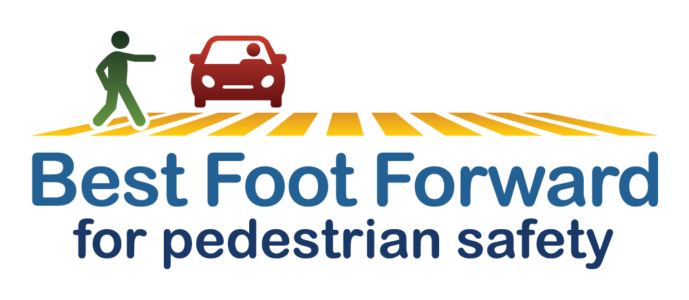Hosted by Bike/Walk Central Florida, the Best Foot Forward (BFF) Summit of 2024 continued its…

Audubon Park Walking School Bus Gets Kids Moving, Alert and Ready to Learn
 A little drizzle wasn’t enough to dampen the spirits of Audubon Park Elementary students and parents as they started the year on the right foot, kicking off their walking school bus program on Wednesday, January 10.
A little drizzle wasn’t enough to dampen the spirits of Audubon Park Elementary students and parents as they started the year on the right foot, kicking off their walking school bus program on Wednesday, January 10.
A walking school bus (WSB) is a group of children walking to school accompanied by one or more adults. If that sounds simple, it is, and that’s part of the beauty of the walking school bus. It can be as informal as two parents in the same neighborhood taking turns walking their children to school or as structured as a defined route with meeting points, a timetable and a regularly rotated schedule of trained volunteers.
The Audubon Park Elementary WSB plans to meet each Wednesday at three locations for walks to school. “We’re testing it out in January and making adjustments as needed,” said Jen Muntean, one of the WSB team captains who will escort children from their meeting location to school.
Audubon Park Elementary had some good examples at other Orange County Public Schools in the area to follow as they planned and launched their program with the support of Healthy Central Florida.
“Lake Sybelia Elementary’s walking school bus has been going strong each Wednesday for six years,” said Michelle Morrison, Healthy Central Florida Walking Coordinator. Healthy Central Florida with founding partners Florida Hospital and Winter Park Health Foundation offers grants and strategic support to local schools making walking and biking to school safer. “Our Walk n’ Roll program of encouraging a culture of walking and biking to school has also thrived at ten area schools such as Dommerich Elementary and Maitland Middle for five years. We’d like more schools to launch a walking school bus program and nurture healthy lifestyles.”
 The WSB model aims to reduce vehicular traffic near campus, eliminate dangerous student drop-offs (outside of the car queue), increase safety for students bicycling and walking, motivate parents and students to try a walking commute, build community and improve health — all while having fun. Why is it called a “bus?” Because students are “picked up” at designated stops and then walked to school along a route that would otherwise be driven.
The WSB model aims to reduce vehicular traffic near campus, eliminate dangerous student drop-offs (outside of the car queue), increase safety for students bicycling and walking, motivate parents and students to try a walking commute, build community and improve health — all while having fun. Why is it called a “bus?” Because students are “picked up” at designated stops and then walked to school along a route that would otherwise be driven.
About 35 students signed up for the Audubon Elementary WSB kick-off and more were “picked up” along the way. “If it starts to look fun, kids are going to want to participate and encourage their parents to let them,” said Rick Schreiber, father of two sons and husband to Lisa the Audubon Park WSB organizer.
Fourth-grader Noah was excited about joining the walk to school. “This is fun! I have only walked to school one time in the three years I’ve gone to Audubon Park,” Noah said.
Noah’s enthusiasm and that of his friends and their parents was contagious. With this kind of excitement, the desire to walk to school is sure to spread. Check out some photos from the event on our Flickr page.
Why should your school start a Walking School Bus?
Thirty years ago, 60 percent of elementary school students in America walked to school. Now, less than 15 percent of elementary kids do so. While the percentage of children walking to school has decreased, childhood obesity rates have steadily increased. Research shows that children who walk to school are healthier, more alert and ready to learn.
What are the Benefits of Walking School Buses?
- Increase in daily physical activity for students, helping to form healthy habits
- Pedestrian experience and education for students
- Students arrive at school alert, awake, and ready to learn
- Reduction in traffic congestion around schools
- Increase in family and community engagement and positive social opportunities for students, families, teachers, community volunteers
- Solution for families concerned about unsafe neighborhoods or safe walking routes
Would your school like to start a Walking School Bus?
Starting simple
When beginning a walking school bus, it often makes sense to start with a small bus and see how it works. Remember that the program can always grow. Pick a single neighborhood that has a group of parents and children who are interested. It’s like a carpool—without the car—with the added benefits of exercise and visits with friends and neighbors. For an informal bus:
- Invite families who live nearby to walk
- Pick a route and take a test walk
- Decide how often the group will walk together
- Have fun!
For more information: http://www.walkingschoolbus.org/
(Source: National Center for Safe Routes to School)




This Post Has 0 Comments